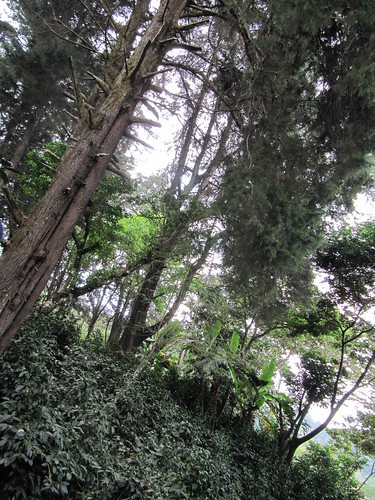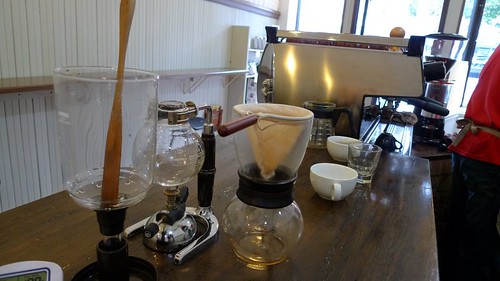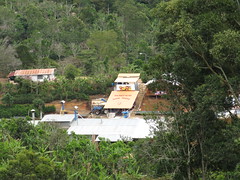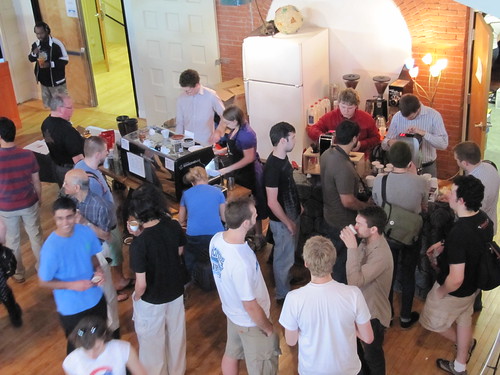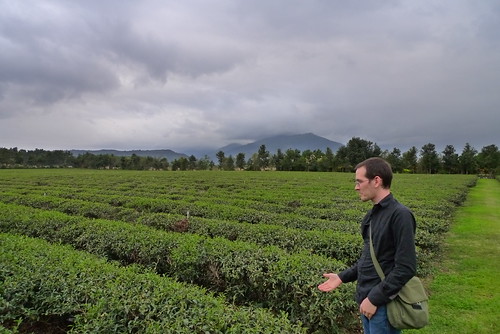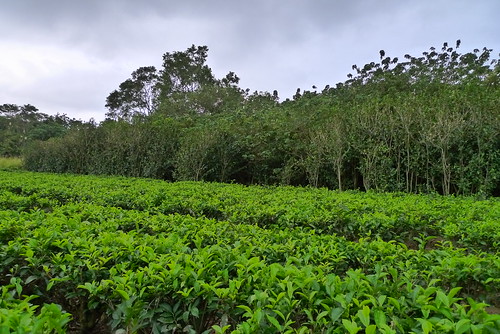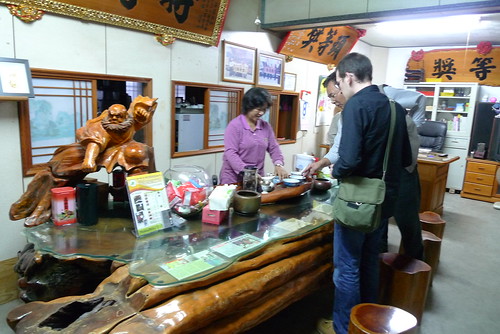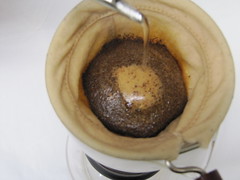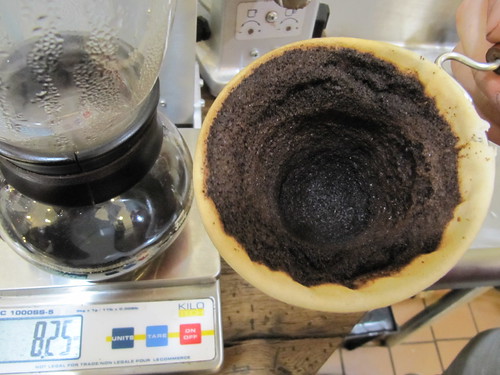Wednesday, December 29, 2010
Espresso updates
A pairing of two Colombia lots: Meridiano and Matambo. We will be looking for feedback on this but the idea is an espresso that's clean, bright, fruited, with a layered clarity. We are going ot test the lighter end of our espresso roast profiles for this one. To that end our proposed name is Lucid. Expect Lucid espresso to hit the hoppers in a couple of weeks.
We are also planning on updating the Soma to get back to the Guatemala, Guatemala, and something fruited equation it had previously been. We worked on adding a Kenya to it earlier but struggled to get what we wanted out of it. We are now adding some of Miriam de Villanueva's El Bosque to the mix. That coffee paired so amazingly well with Armando Melgar's La Trinidad in Z10 that we just love how it can bridge the flavors of the other two coffees so well.
That put's the current blend ratios as such:
40% Colombia El Meridiano
40% Guatemala La Trinidad
20% Guatemala El Bosque
We have also been playing around with added materials for coffees including back labels with tidbits about some of the farms and helpful brewing advice. Keep an eye out for those!
Wednesday, December 08, 2010
A little information about potential pour over filters
Sunday, December 05, 2010
Telling you it's good vs Sharing the good
The best way to explain this is the potential faux pas of putting milk in your drip coffee. We do a pour over brew which takes quite some time to brew and a whole lot of attention. I have been to many a shop which does just this in varying forms. If a customer asks us for milk, we politely provide it but softly encourage them to taste it first to determine if it is necessary or to what degree they would prefer it. We try to make sure they understand that defaulting to their previous dosing of milk might not get the same results. Granted, we are talking about a small group of our customers but they seem to be ones that really rattle a lot of other shops trying to present themselves as 'hard line' or 'purist'. Maybe we aren't so hard line/purist, just very focused in what we want to do.
A common occurrence I have seen or heard proudly discussed by barista at other shops is how they challenged the customer not to put milk or sugar in it or simply restricting options. A famous 'blow up' example of this type of '3rd wave behavior' is the espresso over ice situation. A less public version is when you hear a barista bragging about taunting a customer to not put milk/sugar in their coffee/espresso drink. Visiting with a few barista, one such incident came up where a barista bragged to me about wagging a finger at a customer not to put sugar in their coffee. I politely pointed out we had just been discussing the harshness of the crema in the shot only minutes before. It could be possible that the drink needed a little sugar to this person's taste preferences. As proud as we are to serve the coffees we do (as progressive barista in general), sometimes they aren't living up to the ideal we put in front of them. How you get someone to stop and think about it before doing what they always habitually do is a delicate challenge. Sometimes they may be right, there might be something off and it needs a little something to correct.
That's what it really is about. People and their preferences, finding a good match when they enter our shop. When someone comes in, we try to put them with the coffee they will really enjoy, not force our preferred coffee choices on them. We are however a business that only seeks to showcase coffees we like in methods we have vetted and chosen for the most unique expressions. This means we always run the line between denying certain customers and turning some people away to get at the ones who will appreciate the things we do.
Wednesday, December 01, 2010
Louisville Barista Bash 004
There are a few things you need to know about the scene in Louisville: they are great hosts, serious about coffee, and the shop to shop camaraderie is something we could all learn from. I was certainly surprised by the amount of home roasters locally and how engaged, curious, and yes... polite that everyone was. It was refreshing that while the community may feel it has a long way to go to catch up with the noise coming out of the perceived coffee hubs, there is a good group of people there at the forefront.
I was honored by the discussions, the attention to what we are doing here in Arlington and I want to extended a big thanks to everyone there for having me down to speak. It was a lot of fun, great perspective, and I am more than a little worn out afterward!
Inserts of the core presentation on per cup bars I gave at the Louisville Barista Bash 004. These concepts are borrowed from some core Marketing concepts and the talk was an overview with Q&A rather than specific execution of a bar.
Building a per cup bar:
I. CONTENT
Goals for Per Cup (Coffee on demand)
As A Main Service
- To Contrast bulk brewing drip programs with freshly brewed cups.
- The Pros:
- The Cons:
As A Supplementary Service
- A coffee of the day (or method of the moment) service to provide an alternative to the standard offerings.
- The Pros:
- The Cons:
II. MESSAGE
Conveying a clear message is key.
- Menu
- Appearance
- Service
The dialogue that results.
- Interaction
- Engagement
- Discussion (Customer to Server AND Customer to Customer)
Monday, November 29, 2010
The need to calibrate
Here are a few things to calibrate and a few easy ways to calibrate them.
Scales: Some scales come with a gram weight which can be used for calibration. Alternatively, you can purchase a set of weights for calibration purposes. For your small scale that would be measuring amounts such as gram doses, a nickel is a good calibration tool. A nickel weighs 5g and once you have zeroed and tared your scale, you can simply place a nickel on it to see if it is accurate. A better way of calibrating a scale though is to measure the maximum capacity of the scale. If the scale maxes out at 5lb, finding something like a 5lb bag of sugar to measure the maximum of the scale. RTFM applies in all situations as many models of scales have calibration modes outlined in the manual.
It is also a good idea to make sure the scale you use for measuring small gram dose weights has a small enough resolution to be practical. Some scales have resolutions that vary as much as 5g as they are designed for weighing larger amounts, some are used for precision measurements of small amounts but need to be tared often or reset and tared between measurements.
Thermometers: Thermometers are easy to calibrate and hopefully everyone manual brewing coffee is measuring temperature. To calibrate a thermometer, simply fill a cup with mostly ice and a little bit of water allowing more than 80% of the probe to be submerged. Let the thermometer sit submerged for one minute and then observe the temperature. It should measure at 32f/0C. In conjunction, a measure of water at a rolling boil can give another data point. Placing the same probe into water at a rolling boil should give you a measuring point of 212f/100C unless you are at high elevation to which your boiling point may differ. (To verify espresso temperatures, we recommend getting a Scace and calibrating it the same way in both ice water and boiling to establish group head temperatures.)
Note: The usefulness of calibrating thermometers was most apparent for us. With our installation of two roasters (identical), we found the temperature probes (and spares) had a range of variance within 2 degrees. After identifying the offsets, we then programmed this into the displayed temperatures. When changing the temp probes, we would have to repeat the process of calibration.
Flow Meters: The traditional flow meter in an espresso machine is one of the most difficult items a professional barista can use. In many cases, we tend to abandon this because constant recalibration is needed. The reason being that in the dual boiler machines we use, the volumetric component isn't designed for precision and is placed in a position where hot water sits and scale buildup occurs. This creates many problems that makes it less than useful and often a hinderance. Recalibrating involves either a scale weight of the resulting shot (remember mL and grams are exchangeable) or a volumetric estimate with a 'shot glass.'
In the next year, a new type of flow meter will be introduced in coffee brewing that should not be confused with the volumetric controls on an espresso machine. The LuminaireCoffee volumetric controls are a generation ahead in that they function with more accuracy and are more useful in what they display. As opposed to the volumetric controls on an espresso machine, the LuminaireCoffee flow meter is in the cold water section and has less issues with buildup or hard water. It also is precision and digital which is best exemplified when using it in manual mode as it functions similar to a chronos display of time on a La Marzocco espresso machine. It simply displays total cumulative volume and time counts (and a dynamic flow in either ml/s or oz/min) as you are brewing. (In preset mode, it has cutoffs that can be set to stop the flow at either time or volume points.) Calibration of this is done at production but can also be done by measuring a specific volume of water in a specific time count with a calibrated scale. It makes brewing onto a scale to measure volume a bit superfluous (once calibration is verified). See Flow and Profiling posts for more relevant discussion.
Sunday, November 28, 2010
Right or wrong, it's in the discussion
Saturday, November 27, 2010
Single origin espresso tasting Dec 4th @ Simon's
Tuesday, November 23, 2010
Happy Thanksgiving!
Monday, November 22, 2010
Pressure profiling, flow rate profiling, and the future of temperature profiling
Sunday, November 21, 2010
It's all about the flow (or it should be)
Thursday, November 18, 2010
The state of the local coffee scene
Wednesday, November 17, 2010
Brew specs for the Kenyas
Sunday, November 14, 2010
Kenyas!
The Kianjogu has really started to shine and it's probably my personal favorite right now. That coffee bursts with layers, complexity, and juicy sugary fruit. If you are at the shop and have the chance to get a one cup Woodneck brew, you are lucky. Few things can stick in your memory as much as a descriptive flavor experience like that.
The Finca Bu is coming out extremely well. Really floral and sweet. Another favorite to try but this one is going fast. We thought we had enough supply to last us a while but we have been moving this coffee quickly and it looks like we have another month at most to offer it.
For espresso, the Zone 10, our Guatemala/Guatemala pairing has been exceptional. It is currently our most popular espresso offering. To trump that, we are going to up the stakes on the Soma and put a dash of Kenya into it. Should really up the ante a bit.
The coffee is good, see you in shop!
Monday, November 01, 2010
barismo tasting event at Dave's Nov 13th 1-3pm
Sunday, October 17, 2010
In shop menu
Espresso
Machiatto
Cappuccino (5oz)
Latte (10oz)
and hand pour as well as Syphon coffees:
1 and 2 cup Woodneck
2 cup Syphon
and the off menu option of a v60...
We are currently only offering one espresso at a time to be consistent and really dial it in but it changes daily in most cases. The same for drip coffee though we are considering expanding the offerings soon.
Retail bags get roasted out on Mon, Tue, some Thursdays, and Fridays. We shut down most roasting on weekends to not interfere with the bar service.
That's it. A simple, tightened service with excellent execution and freshly brewed cups!
Wednesday, October 06, 2010
barismo welcomes a new member!
It's going to be a while before the little guy can hold a tamper but I'm sure there is a custom version in the works. Congratulations and best wishes to Ben and his growing family!
Friday, September 17, 2010
Soma espresso is back
Thursday, September 09, 2010
Thoughts on roasting
Tuesday, August 24, 2010
Cold brew coffee tasting this Sun Aug 29th, 12-1pm!!!
Thursday, August 19, 2010
Notes for Aug 19th
 There are a few new options in our lineup to check out:
There are a few new options in our lineup to check out:Wednesday, August 11, 2010
From Guatemala
 We reconnected with Armando Melgar at Finca Trinidad this year and got more of this coffee to revive our Soma project, but the Trinidad will also be available as a SOE. The Trinidad is a very sugar cane sweet coffee with nice balanced aromatics and a soft pleasant body as a shot. It's going to get a lot of mileage in our new lineup.
We reconnected with Armando Melgar at Finca Trinidad this year and got more of this coffee to revive our Soma project, but the Trinidad will also be available as a SOE. The Trinidad is a very sugar cane sweet coffee with nice balanced aromatics and a soft pleasant body as a shot. It's going to get a lot of mileage in our new lineup.
Sunday, August 08, 2010
New crop coffee tasting this Sunday @ 2pm
Saturday, August 07, 2010
Coffee and Chocolate August 22nd 2pm
Sunday, August 01, 2010
Syphon Special Sat, Woodneck Sunday
Thursday, July 22, 2010
Tea Tasting Event Sun 8-1, 12pm to 2pm
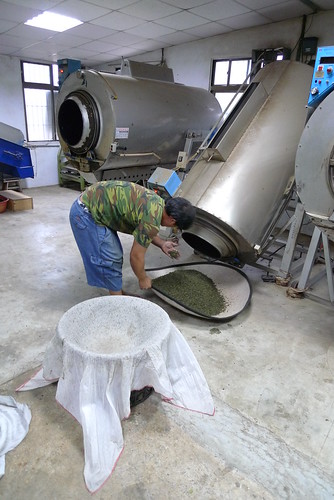
August 1st will be a lineup tasting of our teas purchased directly from small farms in Taiwan. All teas will be presented as cold brew iced teas (Mizudashi) and the event will be a free sampling format.
Come in, ask questions about the farms, and taste our entire lineup!
Saturday, July 17, 2010
v60 and free pour
One of the key tenets of a quality per cup is repeatability. A big reason we teach our method is because it is highly repeatably with the correct tools and an attention to detail.
What we have found though is that having a few extra tools helps. For the Hario Buono kettles, a flow restrictor can be very useful in getting a steady and consistent pour volume over a fixed period of time. I often find myself cringing at the aggressive pours I see from some other industry people which begs the question, why are they even using a kettle if they are going to pour it in there like that?
On the other end of the spectrum is the new Lb-1 which should come out in the fall. We have been playing in shop with it's dynamic temperature adjustments but also, having the flow controls is an exceptional benefit. Being able to dial in the exact ounces per minute to get the flow rate we want for each brew method and then directing the water where we want it is a tool many would love to have. It makes for a very repeatable brew by guaranteeing the same volume of water always flows through as long as the timing is the same.
That's something lacking from a lot of manual methodologies like consistent volumes of water, not to even get into how few people are focusing on temperature control.
Tuesday, July 13, 2010
Monday, July 12, 2010
Fulu Red Oolong!

Photo from our visit to the farm in December.
We have new crop of Shin Fong's Fulu Red Oolong in shop. Brewing it as cold brew tea really brings out the aromatics and deep candy sweetness. This is amazing as an iced tea.
We recommend a 50g per 1 liter of cold water in a Mizudashi.
First steep in the refrigerator for 18 to 24 hours.
Each additional steep should be done to taste and color up to three more steeps before flavor loss occurs.
Sunday, July 11, 2010
New Costa Rican Coffees!
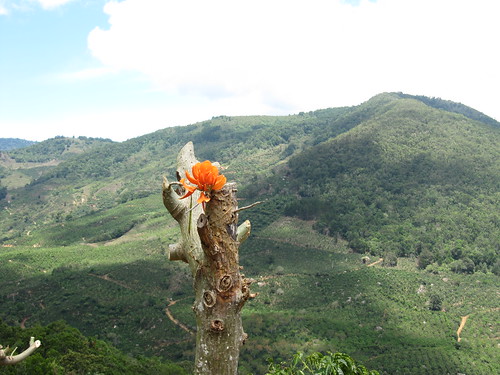
Hiker's view near Beneficio Don Mayo in Costa Rica.
Spent the early part of the day profiling some new Costa Rican coffees. To go with the El Llano, we have just received two lots of Monte Canet through Don Mayo. The two lots have varying characters so it should be a lot of fun to try both side by side. Once we have a week with them, you will see them on the shelves in store and then online early next week. The first lot of Mt. Canet is juicy and clean, nice tangerine citrus. Can't wait to get into the other lot ASAP. We will get our photos together and info on Silas' trip in Costa Rica soon and share them. We have one more special lot on the way from Costa Rica, more on that when it arrives.
Wednesday, July 07, 2010
Marbled drying patios
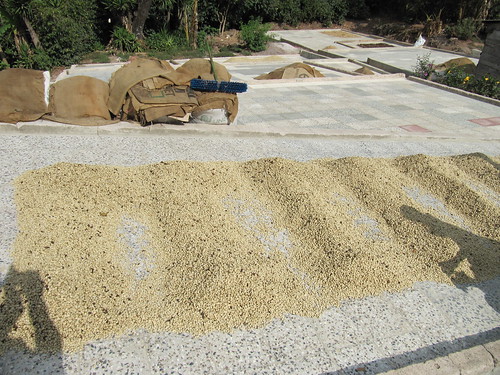
Photo from Finca Trinidad in late March of this year.
Monday, July 05, 2010
Hand Sorting Conveyor Belt
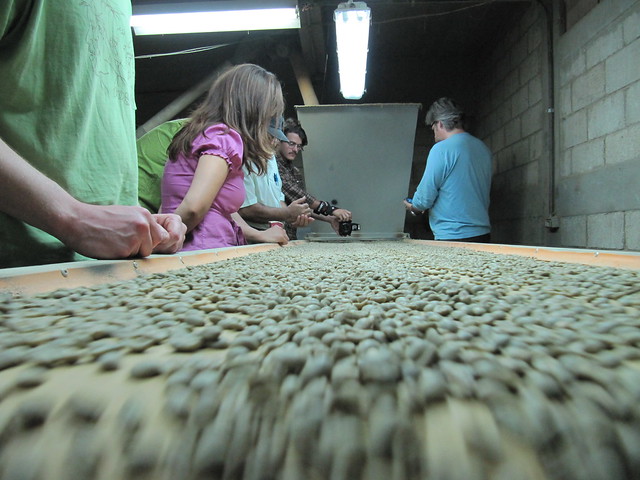
Photo to chew on, a shot from Su Beneficio in Guatemala around March. Trying do a through sort on that thing kinda reminds us of the I Love Lucy.
Sunday, July 04, 2010
Notes for July 4th
A first peek at the new labels comes with the El Llano microlot (soon to be followed by three more Costa Rica offerings). We will also be adding a lot of the information and photos we have collected about our farms to a large info sheet. We are a bit timid about overdoing the labels and losing the clean look though so they won't change much. The problem I find with our style of label and the transparency of it is that it gets imitated a lot nowadays. In September, we will have been open for 2 years. Not a lot of time but we have had the same wine inspired labels since the beginning. Listing blend contents and percentages for the espresso and giving as much pertinent info as we can about each single origin coffee (including the most rare item, how it was packaged in transport from origin). In part, it would be interesting to develop our own standard for seasonality relevant to the method of packaging for marketing purposes but our goals internally don't fit with that kind of approach.
The next few weeks should see the arrival of our Guatemalan offerings. Even with a bad year for output and many farms oversold, we were still able to get the two core farms we wanted to work with. Sadly two more will have to wait until next year. By the end of the month or early next month, we have two Kenyas arriving. We had some trouble arranging these coffees due to a bad year for output but we have found two very solid coffees, one of which is exclusive to us (coined by a friend as a pico- lot) and should be a star in the lineup for those who love fruit. The other problem because of the low production is that the costs are very high this year for Kenyan coffees. We struggled to find the best coffee we could that would match up to the inflated prices and we are lucky the work has paid off. More El Salvador is on the way and Ethiopian coffees are still to come.
We will reopen tomorrow, enjoy the holiday!
Monday, June 21, 2010
LB-1 notes
Sunday, June 20, 2010
El Salvador Las Nubes
Next new coffee, Costa Rica returns to our menu!
New Wabi Sabi series espresso: the Villain
 The newest installment in our Wabi series is a nod to the classic espresso with a clean stylizing. We paired an El Salvador roasted for sweetness and mouth feel with a Brazil roasted for body to get something simple but endearing.
The newest installment in our Wabi series is a nod to the classic espresso with a clean stylizing. We paired an El Salvador roasted for sweetness and mouth feel with a Brazil roasted for body to get something simple but endearing.The las Nubes (El Salvador) has a very sweet pecan, buttery textural notes, with a apricot fruit underneath. The Sao Judas Tedu (Brazil) has a deep body of chocolate and hazelnut that lingers into a pleasant finish as an espresso. The pairing of the two makes for a very balanced offering. Makes for a great classic shot but also holds it's own in a short cappuccino.
The name is a nod to our slightly quirky string of Wabi Sabi names involving somewhat nefarious references. We thought a nod to the black hat/white hat concept fits right in with an espresso that is a bit out of character compared to our previous Wabis.
This blog has moved
For feed subscribers, please update your feed subscriptions!
Thursday, April 22, 2010
A barismo coffee update
Sunday, April 18, 2010
barismo `slow bar day' at Pavement Mon Apr 18th
Monday, April 05, 2010
Cold brew coffee and teas
Sunday, April 04, 2010
NERBC fallout
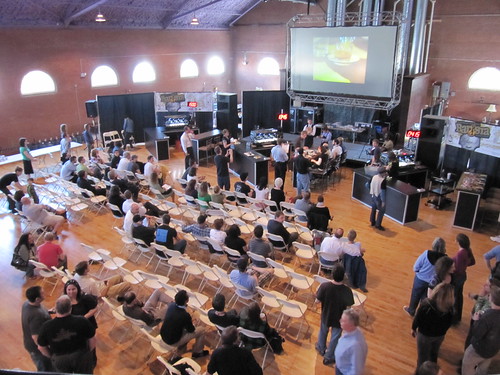
Post NERBC there was a bit of local press coverage from the Globe that really stayed neutral and got quotes from a lot of people there. The globe also did a sidebar piece on Luminaire as well. The Hario brew bar had two of their beta Lb-1 water delivery systems running continuous duty during the 3 days of the event. It was a great field test for their new concept and got them vital feedback from area barista/roasters. We are currently using one in shop right now and there is talk of one at Hi-Rise on Brattle St. as well as Pavement Coffee Bar when it opens. The brew bar and 4th machine were hugely successful and busy during the entire competition. Turnout during all three days was steady but the 4th machine and per cup bars were jam packed consistently.
Sunday, March 14, 2010
NERBC 2010 Competitor list is up
Thursday, March 11, 2010
NERBC 2010 Mass Ave Cafe Crawl: Sat Mar 20th
Diesel Cafe 257 Elm St. in Davis Sq. for Chemex Service
Simon's near Porter Sq. 1736 Mass Ave for v60 service or shots of Competitors Espresso
Hi-Rise on 56 Brattle St. Harvard Sq. for Syphon/Woodneck/Competitors espresso
*Cafe Crema on 27 Brattle St. Harvard Sq. for a special coffee service
*1369 Coffee House on Mass Ave in Central Sq. for a special coffee service
Toscanini's at 899 Main St. in Central Sq. for a special ice cream coffee service
ERC at 286 Newbury St. for Competitor's Espresso Service
NOTE: Cafes with a * are expected to participate but not enough information on actual service was available at time of publishing. I will update it as it becomes available.
Attendees will need to pick up a map at the Somerville Armory Fri or sat before participating in the cafe crawl.
There are other cafes in the area that will want to participate and there will be an expanded map posted closer to time of competition in an online form with mentions of other cafes outside of the Mass Ave Cafe Crawl.
Sunday, February 28, 2010
NERBC 2010
If you are visiting from out of town we recommend getting a hotel here:
Homewood Suites by Hilton® Cambridge-Arlington
1 Massachusetts Avenue, Arlington, Massachusetts, United States 02474
Tel: 1-781-643-7258 Fax: 1-781-643-7298
Ask about the special rates for the barista competitions and remember these are massive suites which are nicely furnished and did I mention, big!
Events and special offerings available for people in town will be posted next week.
Tuesday, February 23, 2010
Chia-Ming tea visit
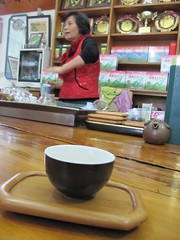 Chia-Ming is a relatively famous tea producer in Taiwan known for it's Honey Cicada Black Tea. In our visit to them, we found out more about this particular tea as well purchasing another pristine Oolong from them.
Chia-Ming is a relatively famous tea producer in Taiwan known for it's Honey Cicada Black Tea. In our visit to them, we found out more about this particular tea as well purchasing another pristine Oolong from them.The Oolong is a semi ball style Dah-Yeh (broad leaf) cultivar. For this elevation, the broad leaf cultivar is quite ideal and produces a sweet clean cup. We were visiting Chia-Ming as this tea was being packed post processing. The leaves are beautiful and unfurl with each steep to reveal nearly perfect preservation of the pick. This doesn't surprise because Chia-Ming is know for it's superior processing skills.
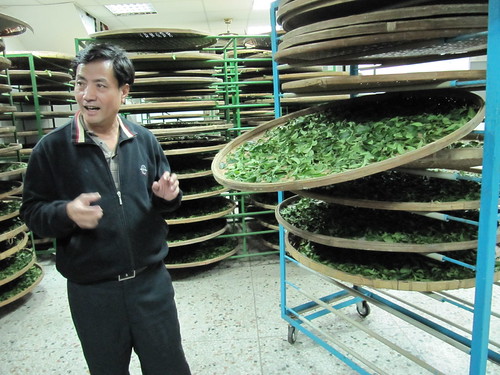
The other tea, Cicada Honey Black, was the byproduct of a unique method noted for it's use of tea green leafhoppers. Normally considered a pest or associated with novelty teas, this particular tea uses these little pests to produce an exemplary experience. The folks as Chia-Ming have learned to identify a specific type of bitten leaf as an ideal pick that when processed to an exacting methodology results in one of the more unique teas experiences you can have. This black tea yields strong aromas, complex sweetness, and a very distinct cup.
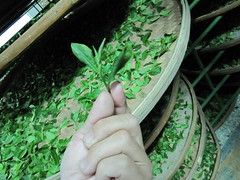 I admit being skeptical about this tea coming in. I had sampled it before through other sources and had what I can only describe as skunky results. Once I arrived at the farm and cupped through all of their lots, the distinctions became clear as to our preferences. We took the silver medal competition lot which was picked as the favorite in the competition by the tea research facility manager in the area. Compared to the gold medal lot, which Chia-Ming also submitted and won, it came as so distinctly special that it was better in our opinion than the more singular gold medal lot.
I admit being skeptical about this tea coming in. I had sampled it before through other sources and had what I can only describe as skunky results. Once I arrived at the farm and cupped through all of their lots, the distinctions became clear as to our preferences. We took the silver medal competition lot which was picked as the favorite in the competition by the tea research facility manager in the area. Compared to the gold medal lot, which Chia-Ming also submitted and won, it came as so distinctly special that it was better in our opinion than the more singular gold medal lot.
Friday, February 12, 2010
Fulu Red Oolong
Thursday, February 11, 2010
Doppleganger espresso
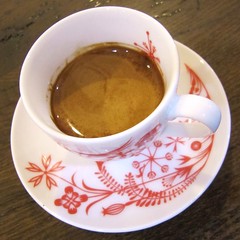 We were playing with shots of the new Wabi series today, Doppleganger.
We were playing with shots of the new Wabi series today, Doppleganger.Shots were coming out taffy cherry with a raspberry nose. It was not a 'fruit bomb' so acidhounds will be disappointed. The fruit comes more taffy than tart, notably better as you let the coffees rest and clarify. We recommend this for a day 7-12 off of roast window. Any earlier and it can be a little unruly with the fruit.
This will hang around for a couple of weeks and then we`ll move on to some new coffees. We have a couple of new arrivals to talk about soon, more on those later.
The crema on this pairing is very persistent but also a little lighter in coloration. With the blend contents, that makes sense but should be noted. I thought it better to post it as is, having been openly critical of other roasters using color corrected photos on their bags or in marketing materials.
Tuesday, February 09, 2010
Tea Tasting - Friday Feb 19th, 4pm - 6pm
Sunday, February 07, 2010
Chin-Suan Oolong

The first steep comes with fragrant pear and honeyed beeswax undertones. This gives way to defined sweetness, and apricot fruitiness, and balanced body in later steepings. This tea is defined by balanced and freshness.
Shin-Fong Grandpa Tea
Known as Grandpa's Assam, this fully oxidized black tea is produced from a traditional Assam cultivar. The trees themselves were planted in 1965, having been abandoned at one time, they were then reclaimed to be grown and cared for with organic practices. The level of care and meticulousness in their farming shows in the pristine look of the trees themselves. At some parts of the Assam grove, the trees have been left to continue growing freely to act as wind breaks as can be seen in the first photo. The Assam picks are rolled paochong style which is not normal for an Assam. This tea however is full oxidized as a black tea which matches well with it's Assam varietal. This combination of factors makes the tea distinct in how it is ideally brewed over multiple steeps, as the tea will need time to open and release it's flavors.
Cup character consists of round caramel aromas that lead into taste notes of candied yam with hints of spice and winter melon. This tea is big bodied with refined tannins but can easily be over extracted due to it's unique processing method. It opens easily in later steeps and is reminiscent of a traditional sweet after a meal drink in that area of Taiwan which consists of sugar and cooked down winter melon.
Classes and updated brew guides
Monday, February 01, 2010
Some specs for the new water delivery system
Sunday, January 31, 2010
The difficulties of per cup
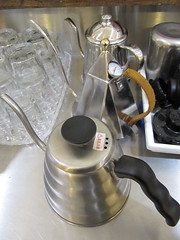
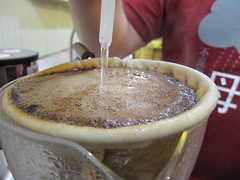 An AWDS that uses technology to provide flow controls and temperature controls would meet the need. It would not be a brewer by itself. Instead, it would provide hot water at precision controlled temperatures and adjustable flow rates through an articulated 'wand'. This would theoretically be the hot water delivery system that worked with all brew methods that could benefit from precision water temperatures and adjustable flow rate controls. All existing and widely used hand pour and general pour over methods would benefit from this system.
An AWDS that uses technology to provide flow controls and temperature controls would meet the need. It would not be a brewer by itself. Instead, it would provide hot water at precision controlled temperatures and adjustable flow rates through an articulated 'wand'. This would theoretically be the hot water delivery system that worked with all brew methods that could benefit from precision water temperatures and adjustable flow rate controls. All existing and widely used hand pour and general pour over methods would benefit from this system. Instead of trying to create a new standalone brew system with new brew physics, a group of engineers have spent the last two years developing a hot water delivery system that functions as an AWDS. After an initial goal of stable temperatures and fixed flow rates, they have now tuned the device to respond to temperature and flow rate changes. That is unprecedented and as yet a largely unexplored avenue of brewing coffee outside of a few lab situations.
Instead of trying to create a new standalone brew system with new brew physics, a group of engineers have spent the last two years developing a hot water delivery system that functions as an AWDS. After an initial goal of stable temperatures and fixed flow rates, they have now tuned the device to respond to temperature and flow rate changes. That is unprecedented and as yet a largely unexplored avenue of brewing coffee outside of a few lab situations.
